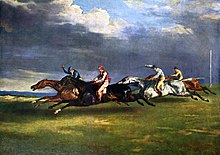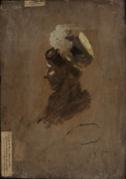The Fairman Rogers Four-in-Hand

|
| The Fairman Rogers Four-in-Hand |
|---|
| Thomas Eakins , 1879-1880 |
| Oil on canvas |
| 60.3 x 91.4 cm |
| Philadelphia Museum of Art |
The Fairman Rogers Four-in-Hand (originally A May Morning in the Park ) is a painting by Thomas Eakins from 1879/1880. It shows Fairman Rogers on the leashes of his four- in-hand horse in Fairmont Park , Philadelphia . It is seen as the first correct representation of horses in motion, which has been achieved through the new technique of photographic analysis.
The painting belongs to the permanent collection of the Philadelphia Museum of Art .
Rogers
Eakins taught at the Pennsylvania Academy of the Fine Arts , where Rogers served on the board and chaired the teaching committee. Rogers brought Eakins back to the academy in 1878 and commissioned him to paint this painting.
Financially independent an engineer and former professor at the University of Pennsylvania , he was an enthusiastic driving enthusiast, founder of the Philadelphia Coaching Club, and author of the still valid A Manual of Coaching (Philadelphia: 1900). Eakins combined Rogers' love for science and horse-carriage in the painting.
Muybridge



Both Rogers and Eakins both admired and watched the groundbreaking work of Eadweard Muybridge in photographing horse movement. In 1877, Muybridge published a photograph of the “Occident” racehorse, which for the first time showed all the hooves galloping in the air. It was considered certain that the horse would be briefly in the air at a gallop with all hooves in the air, but Muybridge showed that this happened in a different phase than assumed (contracted phase) .
The following year he conducted an experiment that went down in film history: Sallie Gardner at a Gallop . On June 15, 1878, he set up 24 cameras in close rows on a racetrack in Palo Alto , which were operated by trigger wires on the track. The racehorse "Sallie Gardner" interrupted the wires every twenty-fifth of a second, creating a sequence of individual images.
Eakins studied the published photos and taught the new findings to his students at the Pennsylvania Academy of the Fine Arts . Eakins biographer Gordon Hendricks reports that seven years before Sallie Gardner's publication, Rogers tried to photograph his own horses with a quick release camera (like a blind). In 1879, Muybridge invited Rogers to California for further experiments. However, since the trip there would have taken seven days from Philadelphia, Rogers spent the summer in Newport , Rhode Island.
With Rogers as a sponsor, Muybridge moved to Philadelphia and continued his experiments at the University of Pennsylvania .
Eakins


Eakins probably visited Rogers in Newport in the summer of 1879, as well as in September, where he may have made a draft of Rogers on the reins of his carriage in the countryside. A wax model of the horses, whose pose was based on Muybridge's work (the Abe Edgington series , 1878, a horse pulling a sulky ) was made there. He made individual studies of Rogers' horses in Newport and Philadelphia. A year earlier he had dissected a horse with students and was now probably using the notes. In the sketch the hooves are more groping than in the finished painting. Based on the sketch, Eakins designed a fan for Mrs. Rogers (private collection).
The finished picture shows Fairmont Park in Philadelphia, north of Memorial Hall . He added more figures to the motif and changed the orientation to better accentuate the hooves. The sketch only shows Rogers and two other people, the painting also shows Mrs. Rogers and other passengers. Two of the studies of the people shown have been preserved. He worked on the work from the autumn of 1879 until the following spring. Theodor Siegl assumes that the landscape background was last created, possibly not until May 1880.
After making the decision to display the hooves in frozen motion, Eakins faced the problem of the carriage wheels. Still blurred in the traditional way in the sketch, Eakins considered abandoning this movement effect and instead showing the individual moment. He seems to have changed his mind several times and the artist Joseph Pennell reported: Eakins "drew every spoke in the wheels, and the whole affair looked as if it had been instantaneously petrified." In the end, Eakins made a compromise and followed the logic of the sketch: The hooves frozen, the wheels blurred.
In 1899 Eakins created a black and white version as an illustration of Rogers' A Manual of Coaching (1900).
criticism
Rogers paid $ 500 for the painting and displayed it in the Philadelphia Society of Artists exhibit in November 1880. The reviews were respectful but disapproving because of the inconsistency in the portrayal of the movement and, in this context, indicated the superiority of art over science. Eakins had tried something new and not everyone understood or appreciated the attempt. At the first exhibition, the picture was not considered a success.
Hilton Kramer wrote in 1985: “… The Fairman Rogers For-In-Hand is a surpassingly dull painting… The painting lacks what for Eakins was always the essential element in art: moral imperative. Representational accuracy, 'scientific' or otherwise, was a necessary co-efficient of this moral imperative in art, but it was not itself a sufficient basis for it. "
Preparatory work
H-3. Photograph of Fairman Rogers on the horse "Josephine" (circa 1878), attributed to Thomas Eakins .
G-130A-C. Anatomical notes on a Horse (1878), Hirshhorn Museum and Sculpture Garden .
G-500. Relief plaque of a horse's skeleton (1878), Philadelphia Museum of Art .
G-135 Landscape sketch of Fairmount Park (1879 or 1880), Pennsylvania Academy of the Fine Arts .
Individual evidence
- ↑ Philadelphia Museum of Art. A May Morning in the Park (The Fairman Rogers Four-in-Hand)
- ↑ Siegl, p. 76.
- ↑ Goodrich, Vol. 1, pp. 171-173.
- ↑ Fairman Rogers . In: The New York Times . August 24, 1900 ( nytimes.com [PDF]).
- ↑ Both correspondences with Muybridge are cited in Hendricks, pp. 49–53.
- ↑ Images used by Eakins are in the Franklin Institute in Philadelphia. Illustrated in Hendricks, p. 58.
- ↑ Hendricks, pp. 55-57.
- ^ Muybridge and the University of Pennsylvania
- ↑ Bronze casts were made in 1946. One set is in the Philadelphia Museum of Art. Siegl, p. 77.
- ↑ Hendricks, p. 49.
- ↑ Siegl, pp. 79-81.
- ^ Joseph Pennell: Photography as a Hindrance and a Help to Art. In: British Journal of Photography. Volume 38, No. 1618, May 8, 1891, p. 295; as cited in Siegl, p. 81. The Philadelphia Museum of Art has found no evidence of overpainting.
- ↑ Hendricks, pp. 55, 60-62.
- ↑ Kramer, 38
literature
- Lloyd Goodrich: Thomas Eakins (= The Ailsa Mellon Bruce Studies in American Art. 2). Volume 1, Harvard University Press, Cambridge, Mass. 1982, ISBN 0-674-88490-6 .
- Gordon Hendricks: A May Morning in the Park. In: Philadelphia Museum of Art Bulletin. Vol. 60, No. 285, Philadelphia, Spring 1965, pp. 48-64.
- Hilton Kramer. The Revenge of the Philistines. Art and Culture, 1972-1984. Free Press, New York 1985, ISBN 0-02-918470-3 .
- Theodor Siegl: The Thomas Eakins Collection, Philadelphia Museum of Art (= Handbooks in American art. No. 1). Philadelphia Museum of Art, Philadelphia 1978, pp. 74-81.













